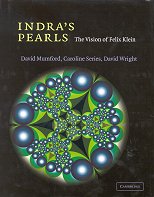Fractal fun with four circles.
![[figure 8.1]](../_misc/pearl_fig_8_1_thumb.jpg)
This is one long investigation into the fascinating geometric
patterns that occur when a group of transformations called Möbius
maps are iteratively applied to some initial special starting circles
(known as Schottky disks). The underlying mathematics is explained,
starting simple, and gradually building up (see for example figure 8.1
reproduced on the right; click
to embiggen). It all started with Felix Klein's extension of
the concept of geometry:
pp1-2.
Klein proposed viewing geometry as 'the
study of the properties of a space which are invariant under a given
group of transformations'. To study geometry, he said, one needed not
only objects (triangles, circles, icosahedra, or much wilder things
like the fractal pictures in this book), but also movements. In the
classical Euclidean regime which had been around for over two
millennia, these movements had always been rigid motions: pick up a
figure and place an identical copy down in a new place. Klein's
radical idea was that other movements, which might stretch or twist
the objects quite drastically, could be thought of geometrical
movements too.
What's different, and nice, here is that algorithms and pseudocode
for drawing the figures are also given and explained, including their
limitations and when they fail. I don't have the time to play with
these, but I wish I did, particularly to watch the serpentine tracing
out of some of the fractals as continuous curves. Given the greater
compute power available today than when this was written, I expect
quite spectacular results can be achieved quite readily.
The progression is typical of mathematics: start with a concept,
then generalise, then generalise again. The fractals start out relatively
simple, but by the end are quite stunning in their intricate
complexity, while clearly all being members of a family. And along
the way, some surprising relationships with other fields appear,
mainly because [p62]
Möbius maps ... do for the Riemann
sphere what the affine maps ... do for the complex plane (and
we are used to the effect of iterating affine maps from
Barnsley's Iterated Function
Systems). In particular, a connection between the (convergent) limit
sets generated here and the (divergent) behaviour of the chaotic IFS
algorithm is demonstrated:
p133.
Independence of starting point is
actually the flip side of the famous butterfly effect in chaos
theory ... The point of this analogy is to explain the feature of
chaos called sensitive dependence on initial conditions (alias
starting points). In our context, we can explain the butterfly effect
like this. If P and Q are nearby limit points, then
their infinite words begin with a long common string W =
aBBaBABABaaa say. Now apply in order the maps A, b,
b, steadily unravelling W. The pairs of points A(P),
A(Q); bA(P), bA(Q);
and so on will get steadily further apart (because their common
strings are shorter and shorter), until eventually we reach the pair
W-1(P) and W-1(Q)
which must be in different initial Schottky disks ..., because they
have no common string at all. In other words, no matter how close P
is to Q, if we run the above process for long enough it will
be completely unpredictable where we end up. Limit sets, it seems, are
closely connected to chaos.
p140.
the limit set is what is sometimes known
as a 'strange attractor' for the group's dynamics, because as we
continue to iterate our maps, then ... the orbit of any point will get
sucked in ever closer to the limit set. A point in the limit set, on
the other hand, hops around chaotically under the dynamics of the
group
Not easy reading, but not dry, and certainly worth the effort, with
plenty of projects to try out.
![[figure 8.1]](../_misc/pearl_fig_8_1_thumb.jpg)
